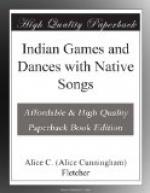When the Leader strikes his staff on the ground every player must stop just where he happens to be, stoop and pick up a bundle with his right hand and begin to wave it above his head and sway his body to the time of the song. When the Leader points with his staff to a player, that person must make a guess. As he scans the waving bundles he points with his left hand that holds his counters to the bundle which he thinks contains the eleven straws. If the guess proves to be correct, the guesser puts one of his counters in his hair or behind his ear. At once all bundles must be thrown in a heap on the mat. The Leader then moves forward by the left, followed by the players, every one singing and keeping time with the song. When the Leader strikes the ground with his staff, all halt. Each player immediately seizes a bundle, holds it aloft and begins to wave it. The Leader designates with his staff a person who must guess. If the guess is wrong, the guesser drops one of his counters on the mat and the Leader points to another player who must guess. If he loses, he drops one of his counters on the mat; the guessing goes on as described, until some one is successful and puts a counter in his hair, when the bundles are all thrown on the mat and the play begins again as before. Should the person designated by the Leader to guess think that he holds the bundle with eleven straws, he must point it at the Leader. If this surmise is correct, the person guessing puts a counter in his hair and all bundles are again thrown on the mat.
In this way the game proceeds until some player has won the requisite number of counters and has them all standing in his hair. Throughout the game the singing must be kept up, accompanied by rhythmic movements of the feet and the body, the players acting as though searching among the tall grass for a desired clump. When a point is won, the Leader should shout out the counter won, without interrupting the song or the play. Among the Indians the game, once started, is kept going without halt or break in the song or the movements. The calling out of the winnings in no way disturbs the singing or the playing.
The victor should wear his successful counters in his hair the rest of the day, if possible.
II
Ata-a-kut
Introductory Note.—This game is played among one of the basket making tribes of California. As not infrequently occurs in Indian games, there is in this pastime a reflection both of the environment and of the vocations of the people who used it. The drama or theme of the play is the search for a particular reed, which for the purpose of the game is marked in a special way.
Properties.—A mat or blanket and about fifty reeds; the reeds should be similar in thickness and about a foot long.
Directions.—The number of points which shall constitute winning the game should first be agreed upon; if ten be the number, then twenty reeds should be set aside as counters and the rest used as game-reeds. All of these latter must be alike save one, and that reed must have a black band about an inch or so wide painted around the middle, that is, midway between the two ends of the reed. It is this particular reed that must be detected or its location guessed.




